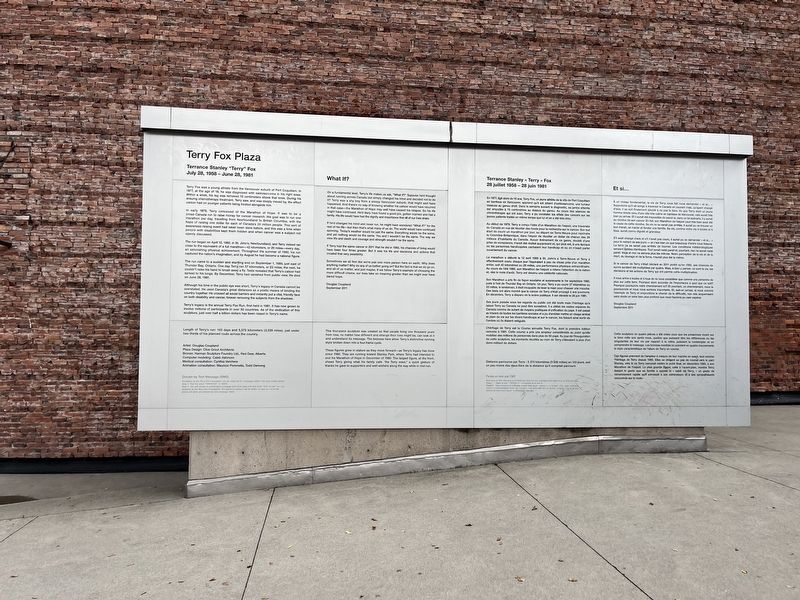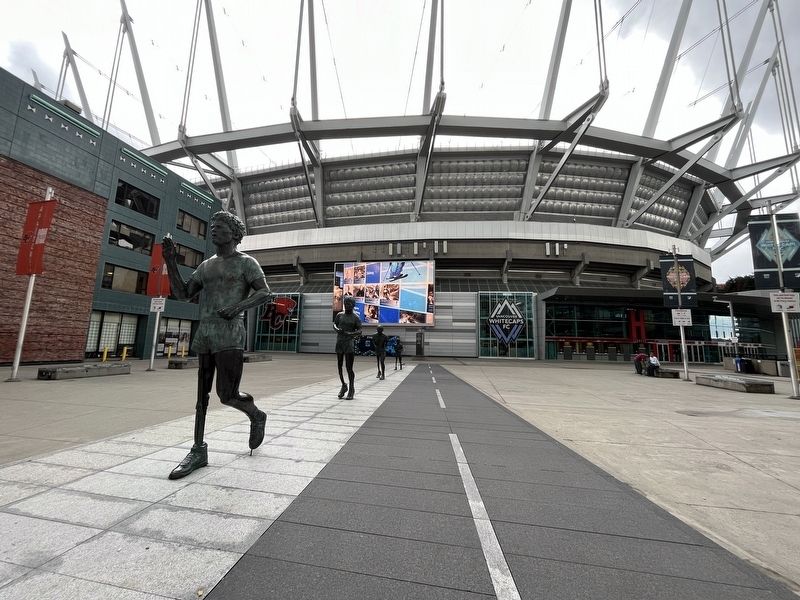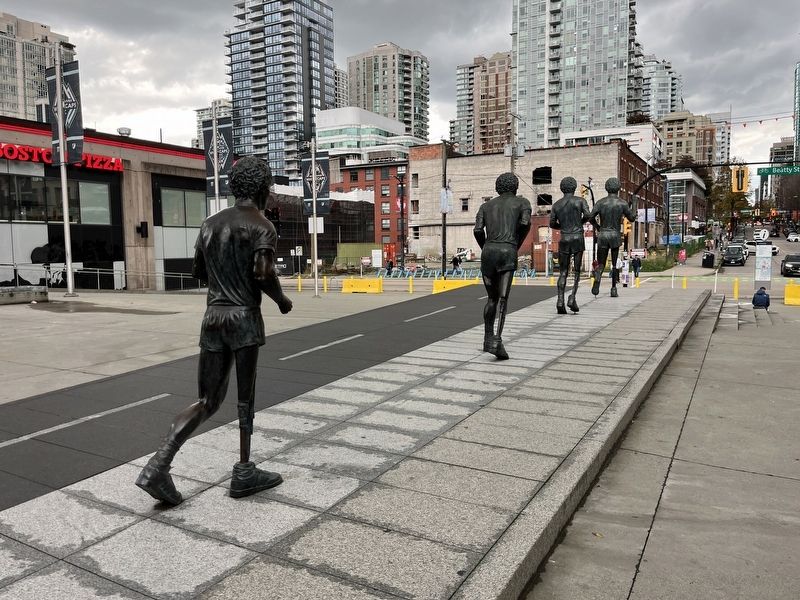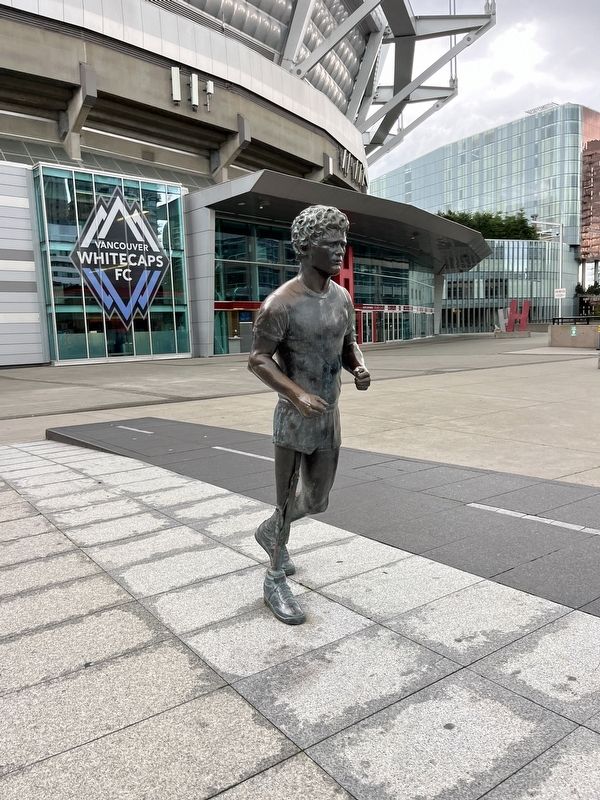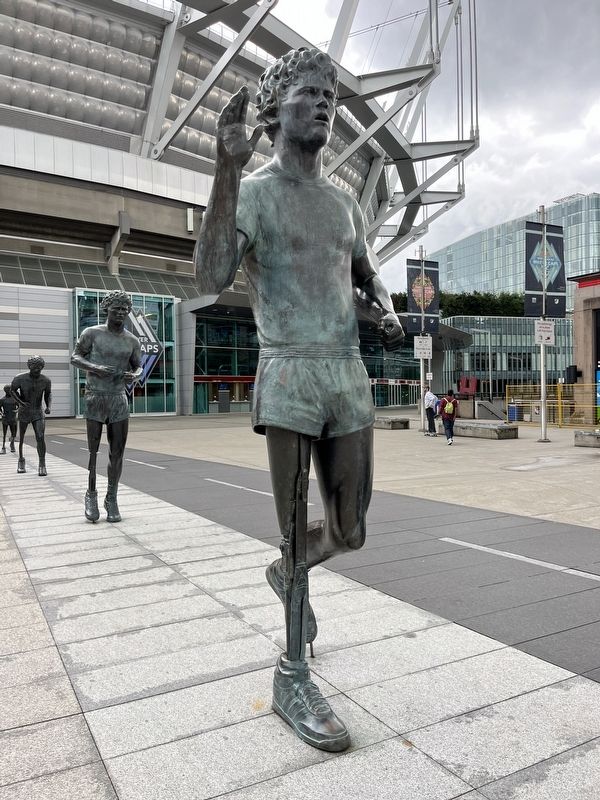Central Vancouver in Metro Vancouver, British Columbia — Canada’s West Coast (North America)
Terry Fox Plaza
Terry Fox Plaza
Terrance Stanley “Terry” Fox
July 28, 1958 – June 28, 1981
Terry Fox was a young athlete from the Vancouver suburb of Port Coquitlam. In 1977, at the age of 18, he was diagnosed with osteosarcoma in his right knee. Within a week, his leg was removed 15 centimeters above that knee. During his ensuing chemotherapy treatment, Terry saw, and was deeply moved by, the effect cancer had on younger patients being treated alongside him.
In early 1978, Terry conceived of the Marathon of Hope. It was to be a cross-Canada run to raise money for cancer research. His goal was to run one marathon per day, travelling from Newfoundland to British Columbia, with the hope of raising one dollar for each of Canada’s 24 million people. This sort of awareness-raising event had never been done before, and this was a time when people with disabilities kept them hidden and when cancer was a subject not openly discussed.
The run began on April 12, 1980, in St. John’s, Newfoundland, and Terry indeed ran close to the equivalent of a full marathon – 42 kilometers, or 26 miles – every day, an astonishing physical achievement. Throughout the summer of 1980, his run captured the nation’s imagination, and by August he had become a national figure.
The run came to a sudden and startling end of September 1, 1980, just east of Thunder Bay, Ontario. One day Terry ran 37 kilometers, or 23 miles; the next, he couldn’t raise his hand to brush away a fly. Tests revealed that Terry’s cancer had spread to his lungs. By December, Terry had vanished from public view. He died on June 28, 1981.
Although his time in the public eye was short, Terry’s legacy in Canada cannot be overstated. He used Canada’s great distances as a poetic means of binding the country together. He crossed all social barriers and instantly put a vital, friendly face on both disability and cancer, forever removing the subjects from the shadows.
Terry’s legacy is the annual Terry Fox Run, first held in 1981. It has now grown to involve millions of participants in over 50 countries. As of the dedication of this sculpture, just over half a billion dollars has been raised in Terry’s name.
What If?
On a fundamental level, Terry’s life makes us ask, “What if?” Suppose he’d thought about running across Canada but simply changed his mind and decided not to do it? Terry was a shy boy from a sleepy Vancouver suburb; that might well have happened. And there’s no way
of knowing whether his cancer would have recurred in that case – the Marathon of Hope may well have caused his relapse. So his life may have continued. He’d likely have found a good job, gotten married and had a family, His life would have had the dignity and importance that all of our lives share.
If he’d changed his mind and never run, he might have wondered “What if?” for the rest of his life – but then that’s what many of us do. The world would have continued spinning. Today’s weather would be just the same. Everything would be the same, and yet nothing would be the same. You and I wouldn’t be the same. The way we view life and death and courage and strength wouldn’t be the same.
If Terry had the same cancer in 2011 that he did in 1980, his chances of living would have been four times greater. But it was his life and decisions and actions that created that very possibility.
Sometimes we all feel like we’re just one more person here on earth. Why does anything matter? Why do any of us bother going on? But the fact is that we do go on, and all of us matter, and just maybe, if we follow Terry’s example of choosing the more difficult choice, our lives take on meaning greater than we might ever have dared hope.
Douglas Coupland
September 2011
Length of Terry’s run: 143 days and 5,373 kilometers (3,339 miles),
just under two-thirds of his planned route across the country.
Artist: Douglas Coupland
Plaza Design: Clive Grout Architects
Bronze: Harman Sculpture Foundry Ltd., Red Deer, Alberta
Computer modeling: Caleb Ashmore
Medical consultation: Cynthia Verchere A
nimation consultation: Mauricio Pommella, Todd Demong
This four-piece sculpture was created so that people living one thousand years from now, no matter how different and strange their lives might be, can look at it and understand its message. The bronzes here show Terry’s distinctive running style broken down into a four-frame cycle.
These figures grow in stature as they move forward – as Terry’s legacy has done since 1980. They are running towards Stanley Park, where Terry had intended to end his Marathon of Hope in December of 1980. The largest figure, at the front, shows Terry giving what his family calls ‘the Terry Wave,’ a quick gesture of thanks he gave to supporters and well-wishers along the way while in mid-run.
Donate by Text Message (SMS)
Donations to the Terry Fox Foundation can be made by text message (SMS) from your mobile phone.
Step 1: Text the word “TERRYFOX” to 45678.
Step 2: You will receive a confirmation message and must reply with the word “YES” to confirm your donation to the Terry Fox Foundation. The donation amount will be added to your next wireless phone bill when you donate by text message (SMS).
28 juillet 1958 - 28 juin 1981
En 1977, âgé alors de 18 ans, Terry Fox, un jeune athlète de la ville de Port Coquitlam en banlieue de Vancouver, apprend qu'il est atteint d'ostéosarcome, une tumeur osseuse au genou droit. Dans la semaine suivant le diagnostic, sa jambe atteinte est amputée à 15 centimètres au dessus du genou. Au cours des séances de chimiothérapie qui ont suivi, Terry a pu constater les effets des cancers sur les jeunes patients traités en même temps que lui et en a été très ému.
Au début de 1979, Terry a conçu l'idée d'un Marathon de l'espoir, une traversée du Canada en vue de récolter des fonds pour la recherche sur le cancer. Son but était de courir un marathon par jour, au départ de Terre-Neuve pour rejoindre la Colombie-Britannique, dans l'espoir de récolter un dollar de chacun des 24 millions d'habitants du Canada. Aucun événement de ce genre, doublé d'une prise de conscience, n'avait été réalisé auparavant et, qui plus est, à une époque où les personnes handicapées cachaient leur handicap et où on n'osait parler ouvertement du cancer.
Le marathon a débuté le 12 avril 1980 à St. John's à Terre-Neuve et Terry a effectivement couru chaque jour l'équivalent à peu de chose près d'un marathon entier, soit 42 kilomètres ou 26 milles, une performance physique extraordinaire. Au cours de l'été 1980, son Marathon de l'espoir a retenu l'attention de la nation et, dès le mois d'août, Terry est devenu une célébrité nationale.
Son Marathon a pris fin de façon soudaine et surprenante le 1er septembre 1980, juste à l'est de Thunder Bay en Ontario. Un jour, Terry a pu courir 37 kilomètres ou 23 milles, le lendemain, il était incapable de lever la main pour chasser une mouche. Des tests ont alors montré que le cancer de Terry s'était propagé à ses poumons.En décembre, Terry a disparu de la scène publique. Il est décédé le 28 juin 1981.
Ses jours passés sous les regards du public ont été brefs mais l'héritage qu'a laissé Terry au Canada ne peut être surestimé. Il a utilisé les vastes espaces du Canada comme de autant de moyens poétiques d'unification du pays. Il est passé au travers de toutes les barrières sociales et a pu d'emblée mettre un visage amical et plein de vie sur les divers handicaps et sur le cancer, les faisant ainsi sortir de l'ombre où ils étaient relégués.
L'héritage de Terry est la Course annuelle Terry Fox, dont la première édition remonte à 1981. Cette course a pris une ampleur considérable au point qu'elle mobilise des millions de personnes dans plus de 50 pays. Au jour de l'inauguration de cette sculpture, les montants récoltés au nom de Terry s'élevaient à plus d'un demi-milliard de dollars.
Distance parcourue par Terry: 5 373 kilomètres (3 339 milles) en 143 jours, soit un peu moins des deux-tiers de la distance qu'il comptait parcourir.
Et si...
A un niveau fondamental, la vie de Terry nous fait nous demander - et s Supposons qu'il ait songé à traverser le Canada en courant mais, qu'ayant changé d'avis, il se soit finalement décidé à ne pas le faire. Vu que Terry était un jeune homme timide venu d'une ville très calme en banlieue de Vancouver, cela aurait très bien pu arriver. Et il aurait été impossible de savoir si, dans un tel scénario, Il y aurait eu récidive de son cancer. En fait, son Marathon de l'espoir peut très bien avoir été la cause de cette récidive. Sa vie ne se serait pas arrétée. Il aurait pu se trouver un bon travail, se marier et fonder une famille. Sa vie, comme notre vie à toutes et à tous, aurait connu dignité et grandeur.
S'il avait changé d'avis et s'il n'avait pas couru, il aurait pu se demander-et si...pour le restant de ses jours - et c'est bien ce que beaucoup d'entre nous faisons. La terre ne se serait pas arrêtée de tourner. Les conditions météorologiques seraient restées identiques. Tout serait resté pareil et, pourtant, rien ne serait resté pareil. Vous et moi ne serions plus les mêmes. Notre perception de la vie et de la mort, du courage et de la force, n'aurait plus été la même.
Si le cancer de Terry s'était déclaré en 2011 plutôt qu'en 1980, ses chances de survie auraient été multipliées par quatre. Mais, à bien y penser, ce sont la vie, les décisions et les actions de Terry qui ont permis cette multiplication.
Il nous arrive à toutes et à tous de ne nous considérer que comme une personne de plus sur cette terre. Pourquoi alors accorder de l'importance à quoi que ce soit? Pourquoi poursuivre notre cheminement ici? Et pourtant, ce cheminement, nous le poursuivons et nous nous sentons importants. Et, sait-on jamais, si nous suivons l'exemple de Terry et empruntons le chemin de la difficulté, nos vies acquerraient sans doute un sens bien plus profond que nous faurions pu oser espérer.
Douglas Coupland
Septembre 2011
Cette sculpture en quatre pièces a été créée pour que les personnes vivant sur la terre mille ans après nous, quelles que puissent être les différences ou les singularités de leur vie par rapport à la nôtre, puissent la contempler et en comprendre le message. Les bronzes montrés ici scindent en quatre mouvements le style caractéristique de l'allure de Terry en course.
Ces figures prennent de l'ampleur à mesure de leur marche en avant, tout comme Théritage de Terry depuis 1980. Elles se dirigent au pas de course vers le parc Stanley, vers là où Terry comptait mettre le point final, en décembre 1980, à son Marathon de l'espoir. La plus grande figure, celle à l'avant-plan, montre Terry faisant le geste que sa famille a appelé le salut de Terry, un geste de remerciement rapide qu'il adressait à ses admirateurs et à ses sympathisants rencontrés sur la route.
Erected 2011.
Topics. This historical marker is listed in these topic lists: Arts, Letters, Music • Charity & Public Work • Science & Medicine • Sports. A significant historical date for this entry is April 12, 1980.
Location. 49° 16.644′ N, 123° 6.824′ W. Marker is in Vancouver, British Columbia, in Metro Vancouver. It is in Central Vancouver. Marker is on Beatty Street. Touch for map. Marker is at or near this postal address: 792 Beatty St, Vancouver BC V6B 2M1, Canada. Touch for directions.
Other nearby markers. At least 8 other markers are within walking distance of this marker. Percy Williams Statue (within shouting distance of this marker); Ram Mk II (approx. 0.3 kilometers away); Drill Hall (approx. 0.3 kilometers away); Sherman (approx. 0.3 kilometers away); 64 Pounder Guns (approx. 0.3 kilometers away); Randall Building (approx. half a kilometer away); 326 West Pender Street (approx. 0.6 kilometers away); BC Permanent Building (approx. 0.6 kilometers away). Touch for a list and map of all markers in Vancouver.
Credits. This page was last revised on November 28, 2023. It was originally submitted on November 24, 2023, by Adam Margolis of Mission Viejo, California. This page has been viewed 56 times since then and 21 times this year. Photos: 1, 2, 3, 4, 5. submitted on November 24, 2023, by Adam Margolis of Mission Viejo, California. • Andrew Ruppenstein was the editor who published this page.
